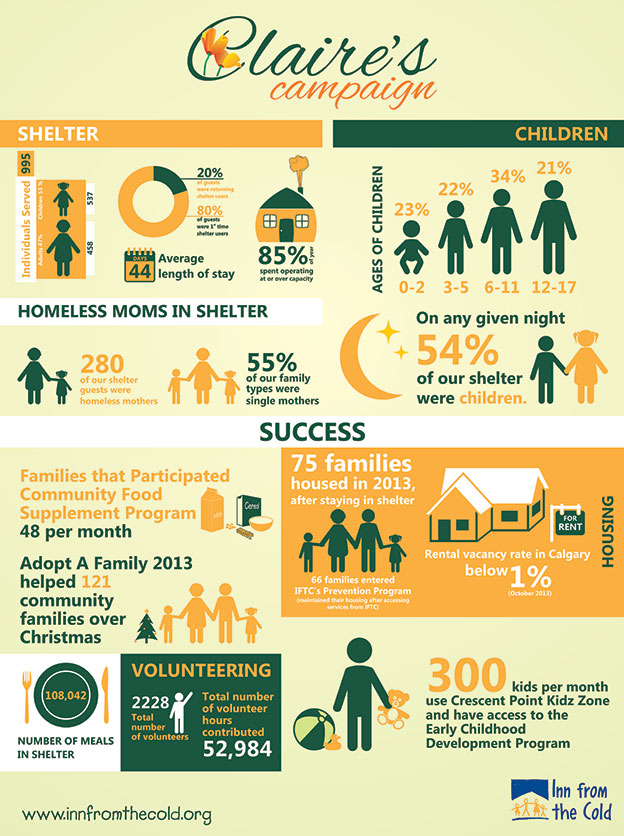Shelters are the cornerstones of service provision to the homeless in many communities across Canada. The below infographic, published by Inn From the Cold, details some information about services offered by this family shelter in Calgary. It's commonly thought that it’s only single men and women that experience homelessness, however this is simply untrue. Single-parent families and children form a substantial part of Canada's homeless population.
While there is a great deal of diversity in the types of families living in homelessness, many of these families are headed by a single parent (usually female). The National Shelter Study, conducted between 2005 and 2009, showed that while the number of individuals using shelters did not change significantly, demographic changes had occurred. These changes included an increase in the number of children and families using shelters. The average length of a family stay went from being 33.4 days in 2005, to 50.2 days in 2009, an increase of over 50%.
The causes of family homelessness include unemployment, low wages and a lack of affordable housing options. Factors predicting homelessness include food insecurity and rising housing costs. These forces work together in developing a precarious situation for struggling families, who often find themselves only one illness, accident, or unexpected expense away from homelessness.
As families are experiencing increased homelessness, it is important that shelters are equipped with the necessary services to meet the needs of both adults and children. This means counselling for families that have been through domestic abuse, training and education, as well as playrooms and toys for children to play with during their stay. Shelters are often placed at the center of a wide network of resources, networks that may include specialized child services, healthcare options, counsellors, and other resources to help these individuals with their unique needs.
Not all communities have the same needs. The infographic states that on any given night, children staying at the Inn made up 54% of occupants. This is in contrast to the National Shelter Study, which states that children made up only 6.5% of all shelter users in 2009. Shelters are often population-specific, which allows them to focus and be efficient in meeting the needs of subgroups that are overrepresented among homeless populations, including shelters for women leaving abusive situations.
LGBTQ2 youth are another example of a subpopulation that is overrepresented among the homeless population in Canada. Many youth are persecuted because of their orientation and may be kicked out of their homes, or elect to leave home because of the discrimination they’ve had to face. 1 in 5 youth in Toronto's shelter system identify as being LGBTQ2, that's more that twice as many identified LGBTQ2 than the area's general population. To date, there are no specialized housing initiatives for LGBTQ2 in Canada. This is despite data that shows LGBTQ2 youth are at higher risk for substance abuse, more likely to be victims of sexual assault and that that shelter workers need training for working with LGBTQ2 youth. Funding, to meet the unmet needs of underserved homeless populations and to continue to provide services to currently funded groups, is largely dependent on community support and committed advocacy.


